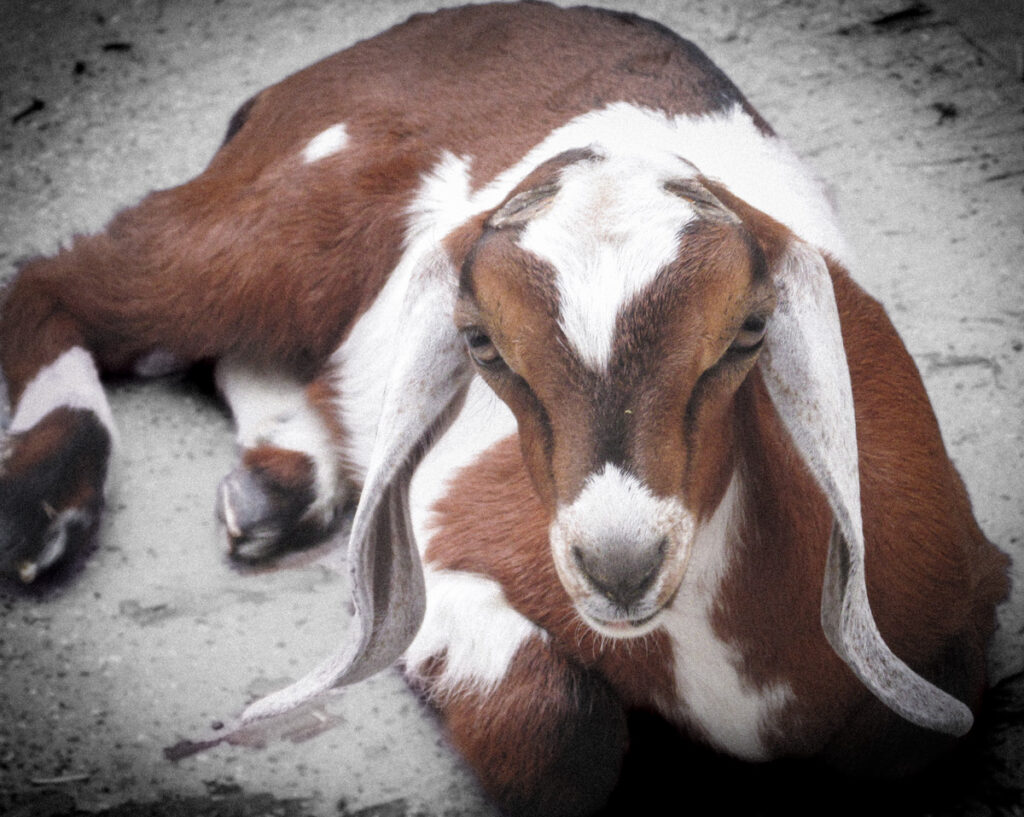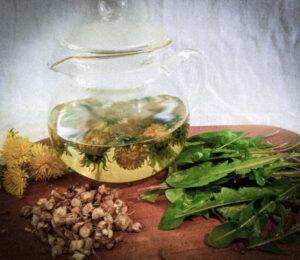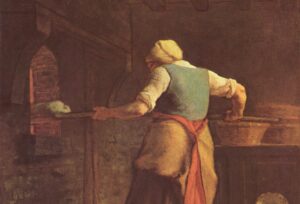
Seven Suggestions for Raising Goats
(and Growing in Virtue)

There are two principal reasons to own goats. First, you want the milk, meat, and weed control they can provide. Second, you want to grow in virtue.
Let’s start with the first reason. Goats are incredible milk producers. Pound for pound, they can transform hay into milk more efficiently than any other ruminant. Likewise, if you raise goats for meat, their relatively quick growth and ease in butchering make them perfect for a source of meat on a homestead. And weeds are usually no match for goats, although they are more selective than one might think. As to the second reason: goats have an endearing penchant for mischief, and, like other livestock, caring for goats will provide you with ample opportunities to grow in virtue (particularly patience) and become a better steward of what you have been given.
Ultimately, owning goats is fun but requires either strong fencing or a strong disposition. Best to have both. Below, we briefly walk through seven time-tested suggestions for raising happy and healthy goats.
1. Select a good breed for your purposes
The principle to “begin with the end in mind” often rings true on the homestead. Goats have been domesticated and bred for generations to highlight particular characteristics, and are relatively purpose-built for what they produce and the environment they will thrive in. For example, Nubians are a docile and loud breed with large floppy ears. They often act like precocious tree-eating canines. They are sweet, and typically raised for milk production, providing an abundance of excellent milk. They do better in warmer climates and can tolerate heat quite well. Similarly, Alpines are designed for milking and, as their name suggests, do well in cold climates. They are easy breeders and tend to build a flock quickly. Boer goats, on the other hand, are bred for meat. They are relatively self-sufficient, with a voracious appetite that leads to quick growth and high meat yields. They thrive in nearly any environment with much less care than other breeds. They are like the Angus steer of the goat world. Kiko goats are a more multi-purpose goat with exceptionally quick growth, but a decent temperament and up to five months of milk production per kidding. A study by the Tennessee Extension showed that Kikos had a lower mortality than Boer goats when used for weed control, likely due to a stronger tolerance to worms and poisonous plants.
These are just four of the dozen or so breeds common in America. Do your homework and select a breed that fits your environment and intended purposes.
2. More is not necessarily better
How many goats do you need? The easy answer is more than one, and not any more than you can handle. Goats are herd animals and need community with other goats, so plan on having at least two.
Goats have a way of teaching you humility and making you live in the truth of what you don’t know. For this reason, we recommend starting small and growing your herd along with your increasing ability and comfort with handling them. Both will grow in time.
From a production perspective, calculate how much milk or meat you want and examine the inputs necessary to get there. For example, two to four Nubian goats will produce one to two gallons of milk a day, depending on the quality of the goat. A well-sized full-grown Boer can yield over a hundred pounds of finished meat. How much milk or meat do you want or need?
If you plan on having milk, goats follow the natural course of mammalian biology and will only produce milk after giving birth to a kid.
If you plan on babies, you will, of course, need both a doe and a buck. One buck can cover about thirty does, so don’t get more bucks than you actually need. Bucks tend to be more ornery and smelly, so best to know your limits. Over breeding cycles you will want to carefully rotate bucks so that there is enough genetic variation to keep the herd healthy.
Don’t be intimidated. The fresh milk and homemade cheese will be worth it. But don’t be stupid either. You have nothing to prove to anyone, so proceed slowly, gathering knowledge as you go. Two goats are by definition a herd and will quickly multiply
3. Avoid duds
Whether you are just starting your herd or expanding it, remember that buying a goat is a little like buying a used car. Its reliability is in large part dependent on the care of the previous owner. When selecting a goat, look for some tell-tale signs of good health, ask lots of questions, and know your goat terminology.
Examine the goat and check off the following. Is its coat smooth, with a nice sheen to it? Are the conditions that the goats are kept in clean and adequately sized? Are its hooves trimmed and free from any signs of injury or infection? Are its teeth in good shape? Are its eyes clear and bright? Are the inside of its eyelids pink and not white? Are there no visible lumps on its jowls or shoulders? This brief under-the-hood inspection only takes a minute and will impress any thoughtful goat breeder who has nothing to hide.
Ask the following questions. What was the size, health and temperament of its parents? What were the meat or milk yields of its parents? (When possible getting a visual on the parents can help you determine size and overall quality of the genes). Is the herd free from CL and CAE, two common diseases that affect goats and are routinely tested for by goat breeders? Have the goats been dewormed and received their shots (often this responsibility falls to the buyer)? If you are buying a fully grown doe, ask how many times she has been bred, if she births multiples or singles, if she needs interventions when birthing, if she is a good mother, and what her milk yields are. If you are buying a fully grown buck, ask how many times it has sired, what is the male to female ratio he throws, and the size and quality of its kids.
Goat terminology: A kid is a sexually immature goat. A doeling is a young female. A buckling is a young intact male. A doe is a female goat. A buck is an intact male goat. A wether is a castrated male goat. A disbudded goat is one with its horns removed at a young age. A polled goat is one that is naturally without horns.
4. Good fences make good neighbors
We cannot emphasize enough the importance of good fencing (for a more complete review, see How to own a bull for more than 38 seconds: A Basic Guide to Livestock Fencing). Goats can beat most fencing systems. They jump high, they can climb like mountain goats (which is to be expected), and their foraging instinct is stronger than you can imagine. Having a good fence and giving them a reason not to leave the comfort of their pen or paddock is the best means to prevent escape.
The pen or paddock should be properly sized. If permanent, you want no less than 250 square feet per goat. This size not only allows movement but also prevents the rapid build up of feces. If you rotate paddocks, plan the size according to the food provided. For example, if you set up a paddock in the forest, or on the tree line by the edge of the pasture, you need to estimate how many days feed that will provide for the goats.
Do yourself a favor and use goat-specific four-inch by four-inch no-climb fencing. It is more expensive than cattle and livestock fencing but the smaller holes prevent goats from getting their heads through, or stuck. If you are rotating and don’t want to build separate paddocks, use a good quality, goat-specific electric fence.
5. Goats don’t eat everything
Goats are like toddlers; they often explore their world with their mouths. They will chew almost anything, but are surprisingly selective about what they will actually eat. Goats are browsers, not grazers. They prefer fresh leaves or hay and tend to eat at eye level and above. While they will eat varieties of fresh grass, this is not the best source of food for them. We were once told that goats are like hedge trimmers and sheep are like lawnmowers.
A goat will eat about three to four percent of its body weight each day. If free in a forest or field, goats will eat their fill and avoid the noxious or poisonous stuff. But once we fence them in, we are responsible for selecting safe and nutritious feed. If you are feeding them hay, either due to limited access to browsing during the winter months, or as their year-round staple, get a good quality hay.
Hay varies by region. Typically, legumes like alfalfa and clover are good for does when in milk due to their higher protein content, while grasses like timothy, orchard or brome provide good all-around nutrition for does and bucks.
6. Maintain a healthy herd
Good set-up: Goats need a secure pen, access to fresh water, and the freedom to forage, or a clean place to be fed. They should also have free access to minerals and baking soda. You will need to either move them to fresh forage or bring it to them in the form of hay or fresh cuttings. All that processed food, commonly called “poop” by city folk and “fertilizer” by farmers, needs to be dealt with.
Good rotation or parasite control: Goats are browsers and never meant to be on the same ground for long. A sedentary lifestyle will lead to high worm loads and sickness. If the goats are in a permanent pen, this means periodic mucking and cleaning the pen. If the goats are being moved daily or weekly, you will want enough paddocks to let the parasites in their poop die off. Aim for twenty-eight days before repeating paddocks.
Good skills: While being a farm vet is not required, it’s good to have a basic knowledge of animal care. This is not because goats are hard to raise or needy, but rather because you want to be good stewards of the living creatures God has entrusted to you, and to enjoy the rewards of your labor. Also, you don’t want to run to the vet for easy-to-remedy issues. Keep in mind that a lot of the most frequently used livestock vet products, including vaccines, vitamins, and medicines, are available over the counter at most feed stores. Helpful skills include hoof trimming, measuring and administering dewormer, checking eyes for anemia (using the Famacha scale), castrating, disbudding, and administering shots subcutaneously.
7. Play the long game and learn as you go
This last point is self-explanatory. You will not become a good goatherd—yes that is actually the name—overnight. It takes time, patience, and help from local goatherds (and, potentially, the internet).
Give yourself time to learn the joys of goat herding, and enjoy the fruits of your labor: fresh milk, fresh meat, a decrease in weeds, and an increase in virtue.



















